Oxidative stress and senescence in aging kidneys
the protective role of SIRT1
DOI:
https://doi.org/10.17179/excli2024-7519Keywords:
SIRT1, SASP, oxidative stress, cellular senescence, homeostasisAbstract
Aging leads to a gradual decline in kidney function, making the kidneys increasingly vulnerable to various diseases. Oxidative stress, together with cellular senescence, has been established as paramount in promoting the aging process of the kidney. Oxidative stress, defined as an imbalance between ROS formation and antioxidant defense mechanisms, has been implicated in the kidney's cellular injury, inflammation, and premature senescence. Concurrently, the accumulation of SCs in the kidney also exacerbates oxidative stress via the secretion of pro-inflammatory and tissue-damaging factors as the senescence-associated secretory phenotype (SASP). Recently, SIRT1, a nicotinamide adenine dinucleotide (NAD)-dependent deacetylase, has been pivotal in combating oxidative stress and cellular senescence in the aging kidney. SIRT1 acts as a potential antioxidant molecule through myriad pathways that influence diverse transcription factors and enzymes essential in maintaining redox homeostasis. SIRT1 promotes longevity and renal health by modulating the acetylation of cell cycle and senescence pathways. This review covers the complex relationship between oxidative stress and cellular senescence in the aging kidney, emphasizing the protective role of SIRT1.

Downloads
Published
How to Cite
Issue
Section
Categories
License
Copyright (c) 2024 Waleed Hassan Almalki, Salem Salman Almujri

This work is licensed under a Creative Commons Attribution 4.0 International License.
Authors who publish in this journal agree to the following terms:
- The authors keep the copyright and grant the journal the right of first publication under the terms of the Creative Commons Attribution license, CC BY 4.0. This licencse permits unrestricted use, distribution and reproduction in any medium, provided that the original work is properly cited.
- The use of general descriptive names, trade names, trademarks, and so forth in this publication, even if not specifically identified, does not imply that these names are not protected by the relevant laws and regulations.
- Because the advice and information in this journal are believed to be true and accurate at the time of publication, neither the authors, the editors, nor the publisher accept any legal responsibility for any errors or omissions presented in the publication. The publisher makes no guarantee, express or implied, with respect to the material contained herein.
- The authors can enter into additional contracts for the non-exclusive distribution of the journal's published version by citing the initial publication in this journal (e.g. publishing in an institutional repository or in a book).





